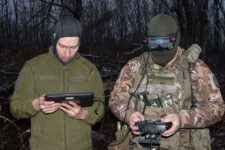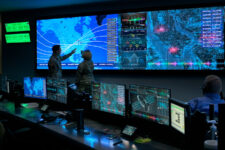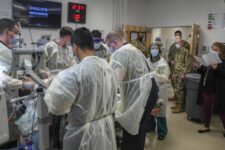
A Standard Missile-3 Block IIA missile launches from the Aegis Ashore Missile Defense Test Complex at Pacific Missile Range Facility in Kauai, Hawaii, Dec. 10, 2018.
WASHINGTON: The next “strategic directive” from the Joint Requirements Oversight Board (JROC) instructing the services how to shape future forces will focus on “integrated air and missile defense,” says Joint Chiefs Vice Chair Gen. John Hyten.
As a first step, he told the annual Space and Missile Defense Symposium in Huntsville, Ala. today, the JROC will do a “capability gap assessment of everything in that portfolio” to be completed sometime in the fall — and which will be folded into the Defense Department’s ongoing Missile Defense Review.
That IAMD capability review will eventually result in a strategic directive, which will mandate the joint requirements for an “overarching structure” for integrated air and missile defense that future service programs will need “to plug into,” Hyten explained.
The JROC’s use of strategic directives is new and are the outcome of Hyten’s long campaign to reform the JROC, which he leads in his role as VCJCS.
The first four strategic directives, issued in June, defined joint requirements for Joint All Domain Command and Control (JADC2), joint fires, contested logistics and information dominance. Hyten has referred to thosee topics as “functional battles,” and they are viewed as pillars for the department’s new Joint Warfighting Concept (JWC).
Notably, Hyten used the SMD conference to announce that the JROC would hold a first industry day sometime in the next three months to explain to industry the JWC, the four functional battles, and the new joint requirements.
The IAMD capability gap review is specifically aimed at helping to inform the Missile Defense Review, a major policy document that both assesses America’s missile defense posture and provides guidance on future investments.
“More importantly, the Missile Defense Review and the Nuclear Posture Review will be integrated as part of the National Defense Strategy,” he stressed. “I think that’s the most important piece of the puzzle, because in the past, the Nuclear Posture Review has been separate from the Missile Defense Review and then, at endgame, it was very difficult to align them together for a singular message.”
The new National Defense Strategy is expected to be finished next January, Leonora Tomero, deputy assistant defense secretary for nuclear and missile defense policy, told the Senate Armed Services Committee in June.

Gen. John Hyten
“My desire was to do an integrated deterrence review,” Hyten said. “The secretary took it one step further and said we’re going to do one National Defense Strategy, under the National Defense Strategy there will be other posture reviews.”
Austin announced the concept of “integrated deterrence” in April at Indo-Pacific Command headquarters in Hawaii. The new approach includes both a focus on cutting edge tech, such as artificial intelligence, and “new concepts of operation, the elimination of stovepipes between services and their capabilities, and coordinated operations on land, in the air, on the sea, in space and in cyberspace,” according to a DoD press release.
“All integrated deterrence is, is taking all our capabilities, not just our nuclear capabilities, not just our conventional capabilities, but our space capabilities, our cyber capabilities, all the capabilities that we have, and applying them to a problem that our adversary faces us with, and when our adversary looks at that and they see it, they decide today is not the day,” Hyten explained.
“When you think about integrated deterrence, the last thing I’ll say is that when it comes to missile defense, it’s about deterring all missile threats,” he elaborated. “It’s about deterring ballistic missile threats, hypersonic threats, cruise missile threats, maneuvering RVs, every threat that’s out there. We have to be able to somehow detect so we can deter, and detect so we can defeat it.”
This will require moving to a posture that integrates “the defensive elements of our architecture with our offensive elements,” Hyten added. “From an adversary’s perspective, deterrence comes from the integration of all capabilities — that means offense and defense; that means nuclear plus missile defense.”
Hyten, who will retire in November, said that if there was one new capability for the Joint Force he would like to see manifest within the next five years, it would be an all-seeing missile sensor network.
“I would like to have overhead sensors that see everything, characterize everything, that goes on on this planet from a missile perspective, all the time, everywhere,” he said. “You have to be able to see it to do anything about it. And that’s a challenge for hypersonics and cruise missiles, that’s a challenge for short range, that’s a challenge for ballistics, that’s a challenge for everything. … That’s unobtainium right now.”
In the meantime, he wants to see DoD move out more quickly to field a layer of new missile tracking satellites that can handle fast-moving, hard to track hypersonic missiles — an effort being spearheaded by the Space Development Agency.
“We have to get there, and we should be able to get there quickly, because that technology is not difficult. In this case, It’s a bureaucratic channels, more than anything else, [in the way]. I’d love to have that [ubiquitous] sensor capability but we need that space layer,” he said.






















